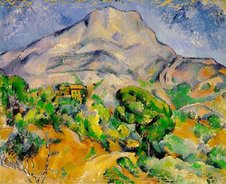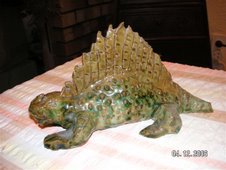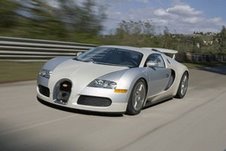One of those misleading pictures off the internet of a meteor "shower " (a time-lapse photograph, or more probably artist's impression, needless to say)
I thought the big one was supposed to be on Saturday night. So I watched the night sky up until midnight, saw one or two streaks across the sky, thought "Mmmm, that's promising" and set the alarm clock for 2am.
So there I was, out on the balcony, in a handy recliner chair, scanning the night sky in search of those "spectacular meteor showers", as gushingly described last night on the 10pm BBC News. In the next hour, I saw just 4 streaks of light across the sky, in other words one every 15 minutes or thereabouts. That's a lot of concentration span for a pretty small payoff, especially as the trails were fairly short, not a patch on some I've seen "accidentally" in previous years.
According to the books, these Perseid meteors, so called because they appear to originate from a single point in the sky, corresponding with the Perseid constellation, should arrive at the rate of some 80 to 100 per hour, but that's for the entire night sky.
I don't know about you, esteemed reader, but my particular configuration of eyes and cervical vertebrae only allows me to see a fairly small part of the night sky, possibly an angle of arc of some 100 degrees at the most. I could try viewing meteors as if on the centre court at Wimbledon, but wonder what any neighbours might make of it.
I had decided not to try a second night, until looking at that BBC News bulletin last night, and hearing that the main spectacle was yet to come. More later about some of the ridiculous hype that laced that announcement.
So last night I tried standing or sitting under our Velux in the mezzanine directly under the roof. The hinged glass was tilted to give a view from north-east to south west.
In the space of the next three three and half hours , with muscle cramp, and the sensation, psychosomatically at any rate, of being bitten around the ankles and legs by every passing mosquito I saw 4 meteors. Yes, just 4 !
Admittedly there was a thin haze that was dimming the stars last night, and there was the inevitable light pollution from Antibes, a sizeable town of some 80,000 souls. Is that so unusual ? How many folk have the luxury of viewing the Perseids from a location deep in the countryside one wonders ? My situation was probably more typical than theirs
During a spell of boredom, or was it muscle cramp, I logged on to MyTel, to read that my friend Ped in Britanny had already seen 10 by midnight, but he didn't seem too impressed by the spectacle. Ped, incidentally, has recently been awarded the title of Grumpiest Blogger on MyTel. Grumpiness must be contagious: I wondered where I'd caught it.
Did I maybe miss a hundred meteors while looking at those comments on the computer screen ? Hardly likely methinks.
Now to the BBC. As someone who has previously taught science, I'm glad in a way that Aunty Beeb talks up the subject, given that it now seems in its death throes in the UK, but she's rather given on occasions to over-hyping (think total solar eclipse) , and last night was a case in point.
It began with a reference to the "spectacular meteor shower". That's a misnomer if ever there was, because meteors usually come singly, widely spaced in time, usually by several minutes.
Those photographs or other representations one sees of "showers" (see graphic above) are time-lapse, taken by special cameras, much beloved by astronomers , since they give a permanent record of events for subsequent scientific study. It is quite wrong to portray meteor trails in real time as a kind of firework display.
Patrick Moore was wheeled out, sorry, I meant to say interviewed, as usual. He produced an ancient woodcut, showing multiple meteors radiating from that single point in the sky. Incredibly, however, unless I was not listening properly, he failed to say that it too was an attempt by our ancestors to portray the effect of time-lapse viewing. There IS no simultaneous fanning out of meteors, of the kind portrayed in the graphic above.
That is not the first time that Sir Patrick has been less than candid about what we ordinary mortals can expect to see - with our own eyes.
I have never really forgiven him for the time I sat up into the early hours expecting to see the first encounter between a space probe and a comet, only to be fobbed off with a technicolor computer image of the comet's nucleus. Why had he not explained at the outset that we would not be seeing real video footage, as seemed to be suggested in the programme trailer ?
Sorry, Sir Patrick, I know you're a colourful character, and much beloved for your "Sky at Night" series, which I admit I rarely watched, maybe because I'm somewhat irritated by your stuffed-shirt, bemonacled TV persona. I prefer my TV scientists to look and sound like ordinary folk, without odd mannerisms or 19th century dress sense.
More importantly you don't pass that vital Ronseal test. You don't do what it says on the tin, namely educate. You simply want us to know that there's a whole universe of stuff out there which we lesser mortals can never hope to comprehend,, unless one happens to be an iconic TV astronomer with the initials PM, looking like an irascible character to whom Berty Wooster would have given wide berth.
We were then shown a short video clip of children supposedly watching a previous meteor event . It could have been taken from a Steven Spielberg film. There was this vast blinding incandescent comet-like object arcing toward the group of youngsters, all squealing with excitement -or was it terror ?
Inevitably, parents then were given a big hint that they should postpone kiddies bedtime, and transport their offspring out into the garden to enjoy nature's pyrotechnics. To persuade any doubters who thought the sofa was more comfortbale, there was talk about meteors travelling at 130,000 mph, before colliding with the Earth's atmosphere, but with no mention of those long waits between fiery collisions, say10 minutes on average if you are lucky. Ten minutes is a long time to look at the night sky, especially if you can't be sure of looking in the right direction.
I don't think the BBC is doing science any favours by making the real world look tame in comparison with what children see on the screen. It's self-serving in a way: "When you are bored and disillusioned, come back to us. We the fabled BBC, do things properly, geared to your microscopic attention span, the result, as often as not, of spending 4 hours a day in front of the screen. "
Nerds corner
Two niggles re the science, both minor, but an irritant if one knows the facts. The Beeb correctly referred to meteors being caused by collisions between dust particles in the tail of the comet Swift-Tuttle - often no more than the size of a sand grain, - with the Earth's atmosphere. They then referred to them encountering "friction" between the outer atmosphere, and then "burning up".
In fact the heating is actually not by friction, but by a ram pressure effect. What is a ram pressure effect ? Er, look it up. That's what encyclopaedias are for.
The dust particles do not "burn up", in the usual sense, there being nothing combustible to burn. Sand, which is silicon (IV) oxide, for example, is fully oxidised silicon. The mineral grains first glow white hot and then vaporise. The light one sees is not from the glowing speck itself, obviously, but from the surrounding air which becomes ionized (electrically charged) by the intense heat from the incandescent particle.
Update: Monday 13th Aug 23:43
The sky is clearer tonight, and I caught a glimpse of a meteor just a minute ago. I might try viewing from the sea front later on.
The Times has an article headed: "Meteor showers provide breathtaking sight, but British clouds ruin the view".
There's just one small problem. Its accompanying photograph purports to show a meteor shower, but as one "Samuel in Chicago" points out, it's nothing of the sort, merely a time-lapse photograph of stars wheeling in the night sky.
I submitted the following comment:
"It's OK for astronomers to describe the phenomenon as a meteor "shower", using time-lapse photography, but it's a total misnomer from the standpoint of an observer, relying purely on his or her eyesight. Even under ideal viewing conditions, it's unlikely one would see more than one trail per minute.
Samuel of Chicago is of course right.
I have today reported on two nights of disappointing viewing in the south of France."
www.dreams-and-daemons.blogspot.com
Submitting and getting published are sadly two entirely different things where the Times is concerned, as I've said before on more than one occasion. Since that paper steadfastly refuses to date- stamp readers' comments, it may be hours before one knows if one's merely held up in a queue or, as usually happens with my contributions, held back. There is no love lost between myself and the snooty Times.
I believe it's time the media stopped referring to meteor showers, and leave that term to astronomers with their time-lapse photography. Let's simply call them "meteor displays" to avoid raising false expectations.
Links: Wikipedia on "Perseids" and on comets
Wikipedia on the difference between meteors, meteroites and meteoroids









3 comments:
I have to admit to being up half the night last night and like yourself I positioned myself looking eastwards as told on the news. Did I see anything? Course not!!!! I was a tad disappointed but seeing as the time is now 1.15am I may have a peek before I climb into bed....bet I don't see a thing though!
Colin, I suggest you try vitamin B pills everyday for the mozzie bites! The mozzies seem to find my husband very tasty but since he has been taking the vit B they seem to have gone off him! Sadly though they seem to have the flavour for me now...very odd as they don't normally like me. I have had 7 bites this week so have started the vit B pills myself now!
J x
Mozzies are a sore point (literally) right now, J, on account of having just this minute been bitten on the ankle in broad daylight.I actually saw the beggar, but he was off before I could splat the gnat.
There is a repellent we use that smells strongly of orange peel, which you may know of. It's very effective, at least for 3/4 of the night - how tedious to have to reapply at 5am! It's the fearsome ingredients list that worries me - I don't like using anything on a regular basis if it's a cocktail of chemicals (15 + perfume).
Vit B pills ? I haven't heard that one before. Is that pure B vitamins or yeast tablets ?
Sorry to hear you missed out last night.
The clouds came over here within minutes after posting, so there was again nothing to see. I'll try viewing from the Phare tonight if it's clear.
When in France I always wonder why the French seem to cater for people sitting outside etc and there is always a wide range of products to scare the flippin' things away but nothing over here on par. A few years back I remember my mum getting bit so badly that each morning we would count the bites...I think she returned home with about 70 bites!!!
We are using plain and simple, cheap and cheerful Vit B from Superdrug and costing about £1.30 for 120 tabs! I would imagine brewers yeast would be as good as others swear that just eating Marmite each day has the same repellant effect.
Oh and by the way....I peered out of the window en route to my bedroom last night and saw nothing but thick rain clouds!!
Post a Comment